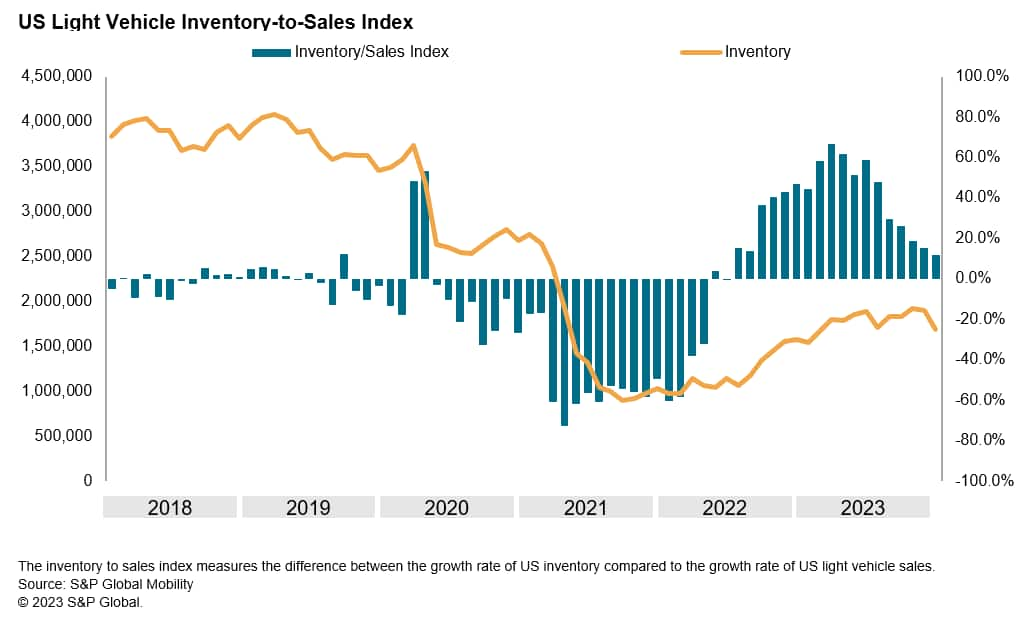
Recovering inventories are escalating seller stock,
although curiosity amount hikes and financial headwinds will dampen need
– forcing OEMs and sellers to make discounts at the time yet again. The dilemma
is: Who will blink first?
By Mark Rechtin, Government Editor, S&P International
Mobility
Just after approximately two yrs of inflated new- and applied-car costs –
with motor vehicle sellers inquiring individuals to pay back hundreds of bucks more than
MSRP – the US business is primed for a reset to previous
competitive norms.
A mix of field things and macroeconomic conditions
could cause a possibly bloody battle for market place share this
yr, according to an assessment by S&P World Mobility.
Automakers and dealers that have grown accustomed to huge income
on automobiles bought as quickly as they depart the manufacturing facility will see a
return to common disorders of accumulating showroom
inventories and the need for incentives to transfer the metallic.
This could mean a large acquire for shoppers nevertheless in the marketplace for
a new or applied car, and who are not intimidated by sharply
elevated lending costs or other financial headwinds. Now there
are indications of amplified new-vehicle inventories and declining utilised-auto
costs – however not but to pre-COVID amounts.
“Points will heat up this 12 months when the initially tranche of
COVID-sold motor vehicles commences returning to market,” predicts Dave
Mondragon, vice president of product progress for S&P Worldwide
Mobility. “These motor vehicles are all underwater. They were offered at
file-higher charges with no reductions, and there will be little to
no equity to roll into a new automobile.”
It truly is not so much the quantity of autos coming back –
new-motor vehicle product sales cratered in 2020 when creation lines slowed owing
to source chain snarls. But the follow by quite a few dealerships of
utilizing car or truck shortages to promote at inflated charges suggests just about
every automobile coming again has massive unfavorable equity – with the
customer owing hundreds of dollars additional than the auto is worthy of
at trade-in. “That’s when discounting commences up once again,” Mondragon
claims.
Stock Rebounding
With source chain snarls easing, an S&P World wide Mobility
analysis of inventory knowledge shows a 91% improve in advertised
new-vehicle supplier stock at the conclude of December 2022 in comparison to
February, a sharp 43% uptick when compared to August 2022, and a 21%
jump in contrast to Oct.
“However we are not back again to historical norms, inventory pressures
are starting to ease,” said Matt Trommer, S&P World-wide Mobility
affiliate director of innovation solution management for in-sector
reporting.
“The only actual variation was domestic and European models
seeing enhanced inventories previously in 2022, and Asian models
ramping up to a bigger extent in the 2nd 50 percent of ’22 following
actually going down in the February-to-August period of time,” Trommer
mentioned. “In a couple of conditions, we are observing inventories coming up very a
little bit. Jeep, GMC and Mazda are now demonstrating a broad availability of
automobiles. Other brand names these kinds of as Honda, Kia and Subaru, having said that, are
exhibiting a lot more constrained availability.”

“We are in the formative stages of inventory rebuilding following
six months of 12 months-above-yr increases that ended 35 months of
calendar year-more than-declines in July 2022,” reported Joe Langley, affiliate
director of investigate and investigation for S&P Worldwide Mobility’s
North American Light-weight Automobile Forecasting & Analysis workforce.
“Stellantis is the closest to having normalized stock. They are
heading to have to talk to by themselves, ‘What do we do next?'”
In December, Ford, Chevrolet, Ram, and Jeep had about
300,000 units of leftover 2022 designs marketed as readily available
for sale. Those four makes accounted for 71% of 2022 marketed
inventory outlined by mainstream brand sellers – and 66% of all
dealer-advertised stock when such as luxurious marques. Between
luxurious makes, Mercedes-Benz and Lincoln nevertheless showed the most
remaining 2022 autos in vendor marketed inventory, in accordance
to the S&P Worldwide Mobility examination.
That reported, not every model will be in the similar circumstances.
Soon after the original semiconductor crunch, GM, Ford, and Stellantis
better managed their provide chains and are closer to staying back to
regular creation stages the Japanese makes are nevertheless
battling with source-chain concerns. While much less impacted, Hyundai
and Kia are also working with structural problems of not obtaining
plenty of manufacturing unit capability to meet developing demand from customers.
“We are looking at the US3 currently being the closest to normalized inventory
and they will have to start off inquiring by themselves hard questions
relating to output preparing, merchandise mix and pricing together with
incentives exercise,” Langley claimed. “The surprise of 2023 will be
car or truck availability. It will still be well beneath field norms,
but inventory for the spring selling season will be up 50-70% from
2022 concentrations.”
Another ingredient that could element into greater buyer electricity
in the new-car arena: A softening in inflated used-vehicle values.
When COVID shut down new-car or truck production, demand from customers (and prices)
for employed automobiles soared beginning in early 2021. Data from CARFAX, component
of S&P World-wide Mobility, shows that – pre-COVID – regular weekly
seller listing rates for made use of cars had held steady, a little bit earlier mentioned
$19,000. The very first quarter of 2021 observed a fast rate shock that
resulted in peak pricing of $29,025 in Q1 2022. But very last slide,
made use of-automobile price ranges commenced retreating. By mid-December, CARFAX info
confirmed a retreat to $27,239. And although selling prices are nowhere in the vicinity of
pre-COVID degrees, there is no evidence that inflated price ranges will
hold.
1 opportunity easing of a rate crash: A momentary fall-off in
off-lease cars coming again all through the a few-yr anniversary of the
COVID shutdown, when product sales cratered for quite a few months in 2020. A
shortfall in the accredited-pre-owned phase could possibly resume demand
strain on the new-car or truck side and temporarily keep price ranges
constant.
External Forces
There are commonly multiple brings about of swings in market place actions,
and it appears US light motor vehicle sales have a excellent storm of
culminating situations that will occur to a head commencing in spring
2023: In addition to rebounding auto inventories, a sharp rise
in U.S. lending fees, inflation leading to lower disposable cash flow
among homes, and nervy macroeconomic headwinds are stressing US
buyers.
Presently there are storm clouds on the horizon in conditions of desire
destruction. The each day new-motor vehicle advertising fee metric remained
remarkably continual in the 2nd half of 2022, even though some
pockets of inventory amassed. Even though stubbornly sticky reduced
concentrations of inventory dampened calendar year-close clearance incentives, any
backward movement in the daily selling metric to begin 2023 could
be sign of a retrenching vehicle customer.
Households are eyeing the uncertain financial state as a purpose to keep
back again on new buys. If personnel do not obtain 2023 pay raises
commensurate with 2022’s unexpected inflationary spike, and significant-scale
layoffs go on, that will prompt conservatism in home
cash expenditures.
“Ongoing offer chain difficulties and recessionary fears will
final result in a careful establish-back again for the market,” explained Chris Hopson,
manager of North American light-weight auto gross sales forecasting for
S&P World wide Mobility. “US people are hunkering down, and
recovery in the direction of pre-pandemic car or truck demand from customers levels feels like a
tough promote. Inventory and incentive exercise will be important barometers
to gauge potential demand from customers destruction.”
From a forecasting standpoint, S&P World wide Mobility a short while ago
downgraded the US need settings for 2023 due to darkening
financial clouds. The fast release of pent-up desire of the
past two a long time that several OEMs anticipated would absorb increasing
creation is now wavering, and may possibly be removed completely if
shoppers retrench their shelling out habits. This will prompt downward
strain on auto pricing.
Who Blinks First?
Where will the reductions initially surface? Probably in total-dimensions
vehicles. GM, Ford and Stellantis want complete-measurement truck volumes and
revenue to help investment in their electrified futures. GM is
the only 1 of the a few that has incremental potential to deliver
a lot more full-dimensions pickups – no matter whether they’re ICE or BEV. Ford is
capability-constrained right up until Blue Oval Town will come online in the
2nd 50 percent of 2025, and Stellantis has their have constraints in
the shorter-phrase.
“This essentially places GM in the driver’s seat if they want to
increase incentives to push extra quantity. If they do this,
Ford and Stellantis will be pressured to adhere to,” Langley explained. “There
is nonetheless place for these companies to enhance incentives on
their pickups and even now be ahead on the revenue side if they
expertise equivalent revenue advancements from people larger
incentives.”
Following all, pre-COVID incentives on large pickups were jogging
$6,000 for every device in January 2020, and the Detroit automakers were being
even now successful. But just lately,
demand from customers for pickups has waned as a lot more purchasers transfer to SUVs.
Despite total-sizing pickups’ essential contributions to every single
brand’s company circumstance and manufacturing unit output, the share of half-ton
retail sales has been declining for extra than two yrs, according
to S&P World wide Mobility details. The segment’s retail share in Q3
2022 was 7.8% – lessen than in any other quarter relationship back again to Q3
2012.
Another place of prospective incentive skirmish? Probable in a
high-quantity section with a good deal of gamers, these kinds of as mainstream
compact SUVs. In addition, a aggressive luxury sector with
added stress from Tesla could see a bigger-conclusion brand name with
resurgent inventories use the prospect to get share. In the meantime,
Tesla’s modern rate cuts across its lineup could prompt a price
war in the BEV space.
At least just one luxurious automaker has said it is openly hunting at
conquesting its rivals, and is now injecting funds into the
current market to capture share. They see it as a the moment-in-a-life span
chance, and are contemplating that investing earlier in incentives
– either hard cash on the hood, or subsidized lending premiums – will
end result in the very best opportunity to seize share. Meanwhile, a different luxurious
brand name with already robust days’ provide is cranking up sponsored
lease deals.
The following automaker’s profits main willing to cede market place share
without having a combat will be the very first 1. Efficiency bonuses, career
trajectories, and factory output necessities hinge on it.
On top of that, failing to devote to keep market place share has downstream
fees: The expense of dropping faithful clients, multiplied by the value
of thousands of conquests needed to change them, will have to also be
regarded as. Also, automakers’ and suppliers’ factories will need to run
at higher percentages of ability to be rewarding. Lofty chat of
stock control appears fantastic, until just-developed motor vehicles start out
stacking up in factory-overflow a lot.
Keep in mind: Common transaction costs in December have been $49,500,
so for each individual 20,000 cars created, OEMs can make practically $1
billion in profits – a tempting carrot for OEMs when profits goals
are below strain.
As a outcome, spring and summer time of 2023 could pressure automakers
into aggressively pursuing buyers with incentives even though
making an attempt to maintain the healthy financial gain margins they have seen
for the earlier two decades.
The upshot will be a chaotic accordion effect in regular revenue
final results, as fluctuating inventories operate head-on into unsettled
customer self-confidence and various business and macroeconomic
problems. Automakers and dealers will be hard pressed to obtain a
persistently successful product sales tactic that enables them to manage
or boost share for the duration of these types of uncertain moments.


This write-up was revealed by S&P International Mobility and not by S&P World Ratings, which is a separately managed division of S&P Worldwide.


 Best New Car Ratings for Safety and Reliability
Best New Car Ratings for Safety and Reliability  Exploring the Top Picks: Unveiling the Best Car Models
Exploring the Top Picks: Unveiling the Best Car Models  Unveiling Excellence: The World of In-Depth Car Reviews
Unveiling Excellence: The World of In-Depth Car Reviews  Inside the Dynamic Car Industry
Inside the Dynamic Car Industry  Unveiling Current Auto Trends
Unveiling Current Auto Trends  Exploring the Latest Motor Trend Updates
Exploring the Latest Motor Trend Updates  Smart budgeting strategies for tradespeople
Smart budgeting strategies for tradespeople  Exploring New Car Ratings: A Comprehensive Insight into Automotive Excellence
Exploring New Car Ratings: A Comprehensive Insight into Automotive Excellence  Vintage Ring Settings Loved by London Couples
Vintage Ring Settings Loved by London Couples